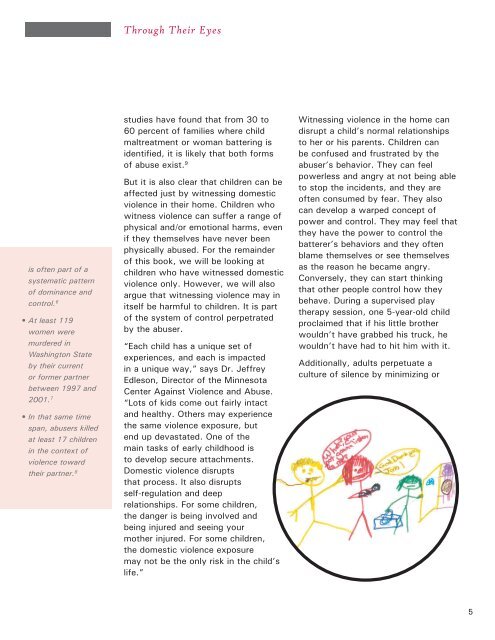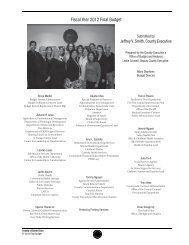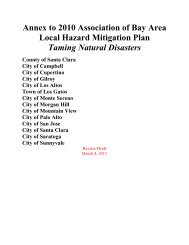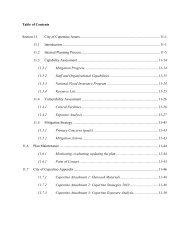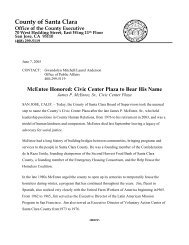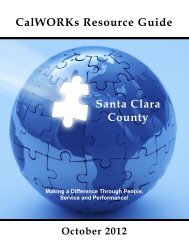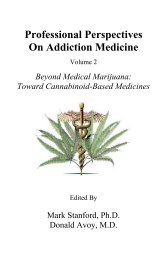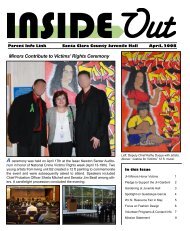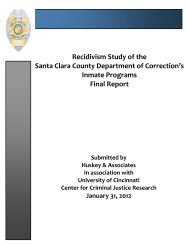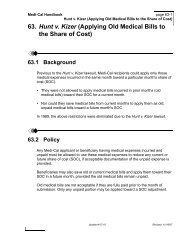Through Their Eyes: Domestic Violence and It's Impact on Children
Through Their Eyes: Domestic Violence and It's Impact on Children
Through Their Eyes: Domestic Violence and It's Impact on Children
You also want an ePaper? Increase the reach of your titles
YUMPU automatically turns print PDFs into web optimized ePapers that Google loves.
<str<strong>on</strong>g>Through</str<strong>on</strong>g> <str<strong>on</strong>g>Their</str<strong>on</strong>g> <str<strong>on</strong>g>Eyes</str<strong>on</strong>g><br />
is often part of a<br />
systematic pattern<br />
of dominance <str<strong>on</strong>g>and</str<strong>on</strong>g><br />
c<strong>on</strong>trol. 6<br />
• At least 119<br />
women were<br />
murdered in<br />
Washingt<strong>on</strong> State<br />
by their current<br />
or former partner<br />
between 1997 <str<strong>on</strong>g>and</str<strong>on</strong>g><br />
2001. 7<br />
• In that same time<br />
span, abusers killed<br />
at least 17 children<br />
in the c<strong>on</strong>text of<br />
violence toward<br />
their partner. 8<br />
studies have found that from 30 to<br />
60 percent of families where child<br />
maltreatment or woman battering is<br />
identified, it is likely that both forms<br />
of abuse exist. 9<br />
But it is also clear that children can be<br />
affected just by witnessing domestic<br />
violence in their home. <strong>Children</strong> who<br />
witness violence can suffer a range of<br />
physical <str<strong>on</strong>g>and</str<strong>on</strong>g>/or emoti<strong>on</strong>al harms, even<br />
if they themselves have never been<br />
physically abused. For the remainder<br />
of this book, we will be looking at<br />
children who have witnessed domestic<br />
violence <strong>on</strong>ly. However, we will also<br />
argue that witnessing violence may in<br />
itself be harmful to children. It is part<br />
of the system of c<strong>on</strong>trol perpetrated<br />
by the abuser.<br />
“Each child has a unique set of<br />
experiences, <str<strong>on</strong>g>and</str<strong>on</strong>g> each is impacted<br />
in a unique way,” says Dr. Jeffrey<br />
Edles<strong>on</strong>, Director of the Minnesota<br />
Center Against <str<strong>on</strong>g>Violence</str<strong>on</strong>g> <str<strong>on</strong>g>and</str<strong>on</strong>g> Abuse.<br />
“Lots of kids come out fairly intact<br />
<str<strong>on</strong>g>and</str<strong>on</strong>g> healthy. Others may experience<br />
the same violence exposure, but<br />
end up devastated. One of the<br />
main tasks of early childhood is<br />
to develop secure attachments.<br />
<str<strong>on</strong>g>Domestic</str<strong>on</strong>g> violence disrupts<br />
that process. It also disrupts<br />
self-regulati<strong>on</strong> <str<strong>on</strong>g>and</str<strong>on</strong>g> deep<br />
relati<strong>on</strong>ships. For some children,<br />
the danger is being involved <str<strong>on</strong>g>and</str<strong>on</strong>g><br />
being injured <str<strong>on</strong>g>and</str<strong>on</strong>g> seeing your<br />
mother injured. For some children,<br />
the domestic violence exposure<br />
may not be the <strong>on</strong>ly risk in the child’s<br />
life.”<br />
Witnessing violence in the home can<br />
disrupt a child’s normal relati<strong>on</strong>ships<br />
to her or his parents. <strong>Children</strong> can<br />
be c<strong>on</strong>fused <str<strong>on</strong>g>and</str<strong>on</strong>g> frustrated by the<br />
abuser’s behavior. They can feel<br />
powerless <str<strong>on</strong>g>and</str<strong>on</strong>g> angry at not being able<br />
to stop the incidents, <str<strong>on</strong>g>and</str<strong>on</strong>g> they are<br />
often c<strong>on</strong>sumed by fear. They also<br />
can develop a warped c<strong>on</strong>cept of<br />
power <str<strong>on</strong>g>and</str<strong>on</strong>g> c<strong>on</strong>trol. They may feel that<br />
they have the power to c<strong>on</strong>trol the<br />
batterer’s behaviors <str<strong>on</strong>g>and</str<strong>on</strong>g> they often<br />
blame themselves or see themselves<br />
as the reas<strong>on</strong> he became angry.<br />
C<strong>on</strong>versely, they can start thinking<br />
that other people c<strong>on</strong>trol how they<br />
behave. During a supervised play<br />
therapy sessi<strong>on</strong>, <strong>on</strong>e 5-year-old child<br />
proclaimed that if his little brother<br />
wouldn’t have grabbed his truck, he<br />
wouldn’t have had to hit him with it.<br />
Additi<strong>on</strong>ally, adults perpetuate a<br />
culture of silence by minimizing or<br />
5


